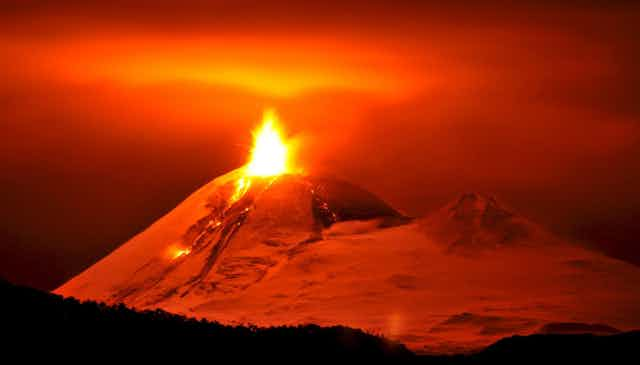No-one alive today has witnessed a volcanic eruption remotely as big as the Toba “super” eruption. But our ancestors may have done, tens of thousands of years ago, when northern Sumatra exploded, creating a caldera now filled by the largest volcanic lake on Earth, measuring 100km by 30km and 0.5km at its deepest. But when, exactly, did it happen?
In a paper published today in the Proceedings of the National Academy of Sciences (PNAS) my colleagues Michael Storey, Mokhtar Saidin and I have finally pinned a date on the Toba super-eruption. It happened 73,880 years ago, with an uncertainty of just 640 years (with 95% confidence).
The eruption
This mega-colossal eruption was the third - and largest - in the last million years at Toba, and the most explosive on Earth for more than two million years.
More than seven trillion tonnes of volcanic material were ejected, of which at least 800km3 was spewed as ash across the Indian Ocean and the adjacent landmasses of South and Southeast Asia, covering several million square kilometres of the planet’s surface in debris.
The Toba blast pumped an equally staggering quantity of sulphurous gases into the atmosphere. The resulting chemical products were transported around the globe and are recognised as sulphate spikes in drill cores collected from ice sheets in Greenland and Antarctica.
The event dwarfs any other historical eruption, the largest of which was Tambora - also in Indonesia - in 1815. Despite being 100-times smaller in magnitude than Toba, Tambora led to a global drop in temperature of about 0.7 ºC and disastrous crop failures across the Northern Hemisphere the following year - dubbed “the year without a summer”.

Given the monumental size of Toba, surely it must have had a correspondingly catastrophic effect on the planet’s climate, landscape, flora and fauna?
And could it have also altered the course of human evolution, reducing the population to such a small size than our ancestors were squeezed through a genetic bottleneck?
Such questions and speculations have provided fodder for researchers since geological evidence for the Toba eruption was first reported at the end of the 19th century.

But, perhaps surprisingly, there remains no consensus at the present time on the climatic or ecological impacts of Toba, and this can be blamed, in large measure, on the fact that the exact date of this explosion had not been fixed to better than a few thousand years, at some point between about 70,000 and 75,000 years ago.
Such a wide margin of error meant that the Toba event could not be precisely aligned with the Earth’s climatic cycles, the comings and goings of animal and plant communities, the dispersals of our early ancestors out of Africa, or the disappearance of other human species in Asia and Europe.
How to date an eruption
My colleagues and I worked out the age of the explosion with high precision by dating crystals of the mineral sanidine using a state-of-the-art mass spectrometer at Roskilde University in Denmark.
Geochronologist Michael Storey measured the tiny amounts of argon gas built up inside the crystals since they were thrust out of the Toba volcano and deposited in adjacent Malaysia, where they now occur in thick beds of ash preserved in the valley bottoms.
In Malaysia’s Lenggong Valley, volcanic ash has buried stone tools that some archaeologists think were made by our early forebears, so our high-resolution age for the Toba eruption suggests that our ancestors were living in Southeast Asia before it erupted, more than 74,000 years ago.

Volcanic impact
So, can we now answer all of the questions that have eluded researchers for so long? The answer, sadly, is no, but we can establish whether this mega-eruption led or lagged some of the most pronounced oscillations in Earth’s climate system, known as Dansgaard-Oeschger events.
From temperature records extracted from the ice caps at both poles and from calcite formations in caves across Europe and Asia, we know that one of the longest periods of cold climate in the last 130,000 years began 74,000 years ago - when temperatures fell abruptly by several degrees centigrade - and ended 72,000 years ago.
The fall in temperature due to the eruption alone would have lasted no more than a few decades, but it may have accelerated or amplified a climatic cooling event already underway, providing positive feedback at a critical moment.
Although geologically brief, several decades of disruption to the climate and landscape could have had devastating ecological impacts, with potentially dire outcomes for humans living at the time of the blast.
The biota living in the vicinity of Toba would have been decimated over the 14-day duration of the eruption, and southeast Asia was then occupied by possibly four known species of human:
- Homo sapiens
- Homo erectus
- Homo floresiensis (the “Hobbits” of Flores)
- Denisovans - an enigmatic lineage discovered from genetic traces in fossil bones and teeth at Denisova Cave in southern Siberia and detected also in the DNA of modern Melanesians and Aboriginal Australians.
It could be that Toba played a role in shaping human interactions, extinctions and dispersals in Asia and Australia, and has left a legacy of the eruption in our genes.
Much remains to be understood about the aftermath of this exceptional geological event, but at least we now know when it happened - to within a few centuries - and can use its ash and chemical remnants to tie together diverse records of global climate, ecology and human evolution.

